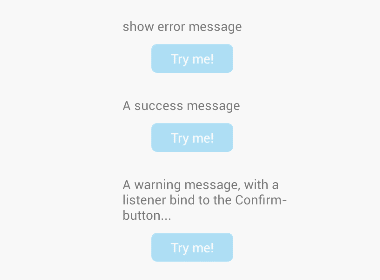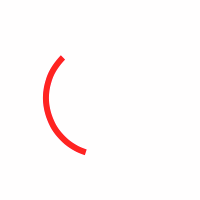बहुत सरल मेरी तीन कस्टम लोडर स्क्रीन बाहर का प्रयास करें:
Viewcontoller.swift फ़ाइल में नीचे कोड लिखें
class ViewController: UIViewController {
var signView = SignView(frame: CGRect.zero)
var testView = TestView(frame: CGRect.zero)
var testView1 = TestView1(frame: CGRect.zero)
override func viewDidLoad() {
super.viewDidLoad()
self.view.backgroundColor = UIColor.orange
}
override func viewDidAppear(_ animated: Bool) {
super.viewDidAppear(animated)
addSignView()
//addTestView()
//addTestView1()
}
func addSignView() {
signView.frame = CGRect(x: 0,
y: 0,
width: UIScreen.main.bounds.size.width,
height: UIScreen.main.bounds.size.height)
self.view.addSubview(signView)
signView.addAnimationLayer()
}
func addTestView() {
let boxSize: CGFloat = 200.0
testView.frame = CGRect(x: 16,
y: 350,
width: boxSize,
height: boxSize)
self.view.addSubview(testView)
testView.addAnimationLayer()
}
func addTestView1() {
testView1.frame = CGRect(x: 0,
y: 0,
width: UIScreen.main.bounds.size.width,
height: UIScreen.main.bounds.size.height)
self.view.addSubview(testView1)
testView1.addAnimationLayer()
}}
अब जोड़े 3 फ़ाइलें UIView साथ वारिस नामित> SignView, TestView और TestView1
SignView.swift के लिए
कोड फ़ाइल TestView फ़ाइल के लिए
class SignView: UIView {
let upCircleLayer = CAShapeLayer.init()
var path = UIBezierPath.init()
var animationDuration : Double = 2
var frameHeight : CGFloat = 50.0
override init(frame: CGRect) {
super.init(frame: frame)
self.backgroundColor = UIColor.black.withAlphaComponent(0.5)
}
required init?(coder aDecoder: NSCoder) {
super.init(coder: aDecoder)
}
var signWavePath : UIBezierPath {
var clockCycle = true
let yPoint = self.frame.size.height/2
frameHeight = self.frame.size.width/6
for x in 1...24{
if x%2 != 0 {
let xpath = UIBezierPath(arcCenter: CGPoint(x: CGFloat(x)*frameHeight/2, y: yPoint),
radius: frameHeight/2,
startAngle: 180.0 * .pi/180.0,
endAngle: 0.0,
clockwise: clockCycle)
path.append(xpath)
if(clockCycle){
clockCycle = false
}
else{
clockCycle = true
}
}
}
return path;
}
func addAnimationLayer() {
// Add Upper Circle Layer
upCircleLayer.fillColor = UIColor.clear.cgColor
upCircleLayer.strokeColor = UIColor.white.cgColor
upCircleLayer.lineWidth = 8.0
upCircleLayer.path = signWavePath.cgPath
layer.addSublayer(upCircleLayer)
animateStrokeUpCircle()
Timer.scheduledTimer(timeInterval: animationDuration, target: self, selector: #selector(animateStrokeUpCircle), userInfo: nil, repeats: true)
}
func animateStrokeUpCircle() {
let strokeAnimation: CABasicAnimation = CABasicAnimation(keyPath: "strokeEnd")
strokeAnimation.fromValue = 0.0
strokeAnimation.toValue = 1.0
strokeAnimation.duration = animationDuration
strokeAnimation.isRemovedOnCompletion = false
upCircleLayer.add(strokeAnimation, forKey: nil)
expand1()
}
func expand1() {
let expandAnimation: CABasicAnimation = CABasicAnimation(keyPath: "position")
expandAnimation.fromValue = [0,sin(self.frame.width)]
expandAnimation.toValue = [-self.frame.width,cos(self.frame.width)]
expandAnimation.duration = animationDuration
expandAnimation.fillMode = kCAFillModeForwards
expandAnimation.isRemovedOnCompletion = false
upCircleLayer.add(expandAnimation, forKey: nil)
}
}
कोड:
class TestView: UIView {
let upCircleLayer = CAShapeLayer.init()
let downCircleLayer = CAShapeLayer.init()
var path1 = UIBezierPath.init()
var path2 = UIBezierPath.init()
var animationDirection : Bool = true
override init(frame: CGRect) {
super.init(frame: frame)
self.backgroundColor = UIColor.clear
}
required init?(coder aDecoder: NSCoder) {
super.init(coder: aDecoder)
}
var up1Circle: UIBezierPath {
return UIBezierPath(arcCenter: CGPoint(x: self.frame.size.width/4, y: self.frame.size.height/2),
radius: self.frame.size.height/4,
startAngle: 180.0 * .pi/180.0,
endAngle: 0.0,
clockwise: true)
}
var down2Circle: UIBezierPath {
return UIBezierPath(arcCenter: CGPoint(x: 3*self.frame.size.width/4, y: self.frame.size.height/2),
radius: self.frame.size.height/4,
startAngle: 180.0 * .pi/180.0,
endAngle: 0.0,
clockwise: false)
}
var up22Circle: UIBezierPath {
return UIBezierPath(arcCenter: CGPoint(x: 3*self.frame.size.width/4, y: self.frame.size.height/2),
radius: self.frame.size.height/4,
startAngle: 180.0 * .pi/180.0,
endAngle: 0.0,
clockwise: true)
}
var down11Circle: UIBezierPath {
return UIBezierPath(arcCenter: CGPoint(x: self.frame.size.width/4, y: self.frame.size.height/2),
radius: self.frame.size.height/4,
startAngle: 180.0 * .pi/180.0,
endAngle: 0.0,
clockwise: false)
}
var up2Circle: UIBezierPath {
return UIBezierPath(arcCenter: CGPoint(x: 3*self.frame.size.width/4, y: self.frame.size.height/2),
radius: self.frame.size.height/4,
startAngle: 0.0,
endAngle: 180.0 * .pi/180.0,
clockwise: true)
}
var down1Circle: UIBezierPath {
return UIBezierPath(arcCenter: CGPoint(x: self.frame.size.width/4, y: self.frame.size.height/2),
radius: self.frame.size.height/4,
startAngle: 0.0,
endAngle: 180.0 * .pi/180.0,
clockwise: false)
}
func addAnimationLayer() {
path1.append(up1Circle);
path1.append(down2Circle);
path2.append(down11Circle)
path2.append(up22Circle)
// Add Upper Circle Layer
upCircleLayer.fillColor = UIColor.clear.cgColor
upCircleLayer.strokeColor = UIColor.black.cgColor
upCircleLayer.lineWidth = 8.0
upCircleLayer.path = path1.cgPath
layer.addSublayer(upCircleLayer)
Timer.scheduledTimer(timeInterval: 2.0, target: self, selector: #selector(expand1), userInfo: nil, repeats: true)
}
func expand() {
if animationDirection{
//upCircleLayer.path = path1.cgPath
let expandAnimation: CABasicAnimation = CABasicAnimation(keyPath: "path")
expandAnimation.fromValue = path1.cgPath
expandAnimation.toValue = path2.cgPath
expandAnimation.duration = 1.5
//expandAnimation.fillMode = kCAFillModeForwards
expandAnimation.isRemovedOnCompletion = false
upCircleLayer.add(expandAnimation, forKey: nil)
animationDirection = false
}
else{
//upCircleLayer.path = path2.cgPath
let expandAnimation: CABasicAnimation = CABasicAnimation(keyPath: "path")
expandAnimation.fromValue = path2.cgPath
expandAnimation.toValue = path1.cgPath
expandAnimation.duration = 1.5
//expandAnimation.fillMode = kCAFillModeForwards
expandAnimation.isRemovedOnCompletion = false
upCircleLayer.add(expandAnimation, forKey: nil)
animationDirection = true
}
}
func expand1() {
let expandAnimation: CABasicAnimation = CABasicAnimation(keyPath: "position")
expandAnimation.fromValue = [0,self.frame.height/2]
expandAnimation.toValue = 500
expandAnimation.duration = 2.0
expandAnimation.fillMode = kCAFillModeForwards
expandAnimation.isRemovedOnCompletion = false
upCircleLayer.add(expandAnimation, forKey: nil)
}
}
और TestView1.swift फ़ाइल के लिए कोड
वर्ग TestView1: UIView {
let animationLayer = CAShapeLayer.init()
var path1 = UIBezierPath.init()
var path2 = UIBezierPath.init()
var path = UIBezierPath.init()
var circleRadius : CGFloat = 26.0;
var centerLineHeight : CGFloat = 40.0
var animationDuration : Double = 2.0
var animationDirection : Bool = true
override init(frame: CGRect) {
super.init(frame: frame)
self.backgroundColor = UIColor.black
}
required init?(coder aDecoder: NSCoder) {
super.init(coder: aDecoder)
}
var centerMainLine: UIBezierPath {
let frameSize = self.frame.size
let centerLine = UIBezierPath()
centerLine.move(to: CGPoint(x: frameSize.width/2, y: frameSize.height/2 - centerLineHeight/2))
centerLine.addLine(to: CGPoint(x: frameSize.width/2, y: frameSize.height/2 + centerLineHeight/2))
return centerLine
}
var upLeftCircle: UIBezierPath {
let frameSize = self.frame.size
let halfCircle = UIBezierPath(arcCenter: CGPoint(x: frameSize.width/2 - circleRadius, y: frameSize.height/2 - centerLineHeight/2),
radius: circleRadius,
startAngle: 180.0 * .pi/180.0,
endAngle: 0.0,
clockwise: true)
return halfCircle
}
var upRightCircle: UIBezierPath {
let frameSize = self.frame.size
let halfCircle = UIBezierPath(arcCenter: CGPoint(x: frameSize.width/2 + circleRadius, y: frameSize.height/2 - centerLineHeight/2),
radius: circleRadius,
startAngle: 180.0 * .pi/180.0,
endAngle: 0.0,
clockwise: true)
return halfCircle
}
var downLeftCircle: UIBezierPath {
let frameSize = self.frame.size
let halfCircle = UIBezierPath(arcCenter: CGPoint(x: frameSize.width/2 - circleRadius, y: frameSize.height/2 + centerLineHeight/2),
radius: circleRadius,
startAngle: 180.0 * .pi/180.0,
endAngle: 0.0,
clockwise: false)
return halfCircle
}
var downRightCircle: UIBezierPath {
let frameSize = self.frame.size
let halfCircle = UIBezierPath(arcCenter: CGPoint(x: frameSize.width/2 + circleRadius, y: frameSize.height/2 + centerLineHeight/2),
radius: circleRadius,
startAngle: 180.0 * .pi/180.0,
endAngle: 0.0,
clockwise: false)
return halfCircle
}
func drawUpCircle(centerPoint:CGPoint, radiusValue:CGFloat) -> UIBezierPath {
let halfCircle = UIBezierPath(arcCenter: centerPoint,
radius: radiusValue,
startAngle: 180.0 * .pi/180.0,
endAngle: 0.0,
clockwise: true)
return halfCircle
}
func drawDownCircle(centerPoint:CGPoint,radiusValue:CGFloat) -> UIBezierPath {
let halfCircle = UIBezierPath(arcCenter: centerPoint,
radius: radiusValue,
startAngle: 180.0 * .pi/180.0,
endAngle: 0.0,
clockwise: false)
return halfCircle
}
func drawLine(fromPoint:CGPoint,toPoint:CGPoint) -> UIBezierPath {
let line = UIBezierPath()
line.move(to: fromPoint)
line.addLine(to: toPoint)
return line
}
func addAnimationLayer() {
createPathOne()
createPathTwo()
createPath()
// set Animation Layer design
animationLayer.fillColor = UIColor.clear.cgColor
animationLayer.strokeColor = UIColor.white.cgColor
animationLayer.lineWidth = 8.0
animationLayer.path = path.cgPath
layer.addSublayer(animationLayer)
expand1()
Timer.scheduledTimer(timeInterval: 10.0, target: self, selector: #selector(expand1), userInfo: nil, repeats: true)
}
func expand1() {
let expandAnimation: CABasicAnimation = CABasicAnimation(keyPath: "position")
expandAnimation.fromValue = [0,0]
expandAnimation.toValue = [-2000,0]
expandAnimation.duration = 10.0
expandAnimation.fillMode = kCAFillModeForwards
expandAnimation.isRemovedOnCompletion = false
animationLayer.add(expandAnimation, forKey: nil)
}
func expand() {
animationLayer.path = centerMainLine.cgPath
if animationDirection{
let expandAnimation: CABasicAnimation = CABasicAnimation(keyPath: "path")
expandAnimation.fromValue = path1.cgPath
expandAnimation.toValue = path2.cgPath
expandAnimation.duration = animationDuration
expandAnimation.fillMode = kCAFillModeBackwards
expandAnimation.isRemovedOnCompletion = false
animationLayer.add(expandAnimation, forKey: nil)
animationDirection = false
}
else{
let expandAnimation: CABasicAnimation = CABasicAnimation(keyPath: "path")
expandAnimation.fromValue = path2.cgPath
expandAnimation.toValue = path1.cgPath
expandAnimation.duration = animationDuration
expandAnimation.fillMode = kCAFillModeForwards
expandAnimation.isRemovedOnCompletion = false
animationLayer.add(expandAnimation, forKey: nil)
animationDirection = true
}
}
func createPathOne(){
path1.append(upLeftCircle);
path1.append(centerMainLine);
path1.append(downRightCircle)
}
func createPathTwo(){
path2.append(downLeftCircle);
path2.append(centerMainLine);
path2.append(upRightCircle)
}
func createPath() {
let frameSize = self.frame.size;
let lineHeight1 : CGFloat = 30
let lineHeight2 : CGFloat = 20
let radius1 : CGFloat = 40.0
let radius2 : CGFloat = 20.0
var lastPoint : CGPoint = CGPoint(x:0.0,y:frameSize.height/2 - lineHeight1/2)
for i in 1...10{
let p1 = drawUpCircle(centerPoint: CGPoint(x: lastPoint.x + radius1, y: lastPoint.y ), radiusValue: radius1)
lastPoint = p1.currentPoint;
let p2 = drawLine(fromPoint: lastPoint , toPoint: CGPoint(x:lastPoint.x, y: lastPoint.y+lineHeight1))
lastPoint = p2.currentPoint;
let p3 = drawDownCircle(centerPoint: CGPoint(x:lastPoint.x + radius1, y: lastPoint.y), radiusValue: radius1)
lastPoint = p3.currentPoint;
let p4 = drawLine(fromPoint: lastPoint, toPoint: CGPoint(x:lastPoint.x, y: lastPoint.y - lineHeight2))
lastPoint = p4.currentPoint;
let p5 = drawUpCircle(centerPoint: CGPoint(x:lastPoint.x + radius2, y: lastPoint.y), radiusValue: radius2)
lastPoint = p5.currentPoint;
let p6 = drawLine(fromPoint: lastPoint, toPoint: CGPoint(x:lastPoint.x, y: lastPoint.y + lineHeight2))
lastPoint = p6.currentPoint;
let p7 = drawDownCircle(centerPoint: CGPoint(x:lastPoint.x + radius2, y: lastPoint.y), radiusValue: radius2)
lastPoint = p7.currentPoint
let p8 = drawLine(fromPoint: lastPoint, toPoint: CGPoint(x:lastPoint.x, y: lastPoint.y - lineHeight1))
lastPoint = p8.currentPoint;
path.append(p1)
path.append(p2)
path.append(p3)
path.append(p4)
path.append(p5)
path.append(p6)
path.append(p7)
path.append(p8)
}
}
}
अब एनीमेशन लोडर की जाँच करने के कोड चलाते हैं। Viewcontroller के DidAppear विधि को देखने में अन्य 2 लोडर विधि को टिप्पणी/असम्बद्ध करें।
आनंद लें !!


(आप कुछ है कि पहले किया गया है बदलने की जरूरत के बिना) ओपन सोर्स प्रोजेक्ट/घटक है कि आप क्या करने की जरूरत नहीं कर सकता हो सकता है । मुझे CocoaControls.com पर दो परियोजनाएं दिखाई देती हैं, जैसे कि [जीएमडीसीकललोडर] (https://www.cocoacontrols.com/controls/gmdcircleloader) और [CircleProgressView] (https://www.cocoacontrols.com/controls/circleprogressview)। –